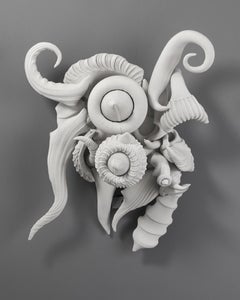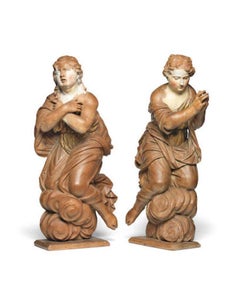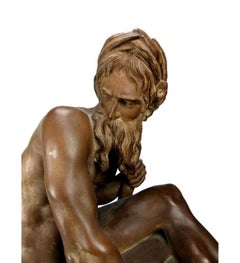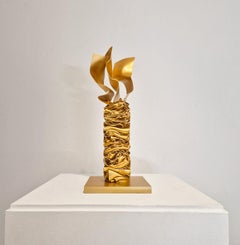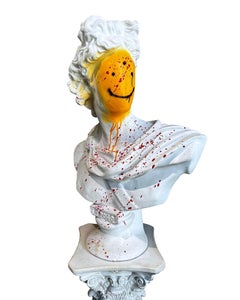Baroque Sculptures
to
15
23
16
11
8
10
Overall Width
to
Overall Height
to
33
12
9
14
1
3
1
3
16
9,845
3,491
1,492
969
459
154
140
110
90
87
63
30
9
6
44
24
24
22
21
14
13
7
5
5
5
2
2
2
2
2
2
2
1
1
23
18
16
15
15
5
4
2
1
43
24
Style: Baroque
Charles Birnbaum, 372 Wall Piece No.20, 2017, porcelain, 19.5x15.5x7 in, Visionary
Located in Darien, CT
Charles Birnbaum is a sculptor and a self-taught photographer. He graduated from Kansas City Art Institute where he studied ceramics and was one of a select group of the esteemed Ken...
Category
2010s Baroque Sculptures
Materials
Digital Pigment, Porcelain
A pair of late 17th century Northern European carved oak angels
Located in Bath, Somerset
A pair of carved oak angels, circa 1700, with a lovely warm patina and faint traces of polychrome to the face and gilding to the body. The angels are both kn...
Category
17th Century Baroque Sculptures
Materials
Oak
$5,999 Sale Price
20% Off
Terracotta sculpture by Caffieri Jean-Jacques (1725-1792), The River
Located in Gent, VOV
The River
Allegorical figure of a river. Terracotta cast (late 19th century) after the marble model by Caffieri in the Louvre Museum in Paris, the sculptor's reception piece at the ...
Category
Late 19th Century Baroque Sculptures
Materials
Terracotta
Putto in legno dorato reggi candela barocco italiano
Located in Florence, IT
One flame candle holder putto made of gilded wood.
Those kind of objects were present in churches or noble villas, specially during the Baroque times.
The base is not coeval.
Category
17th Century Baroque Sculptures
Materials
Gold
Compressed Hyperbaroque XV
Located in Pampilhosa da Serra, PT
15 x 15 x 31 cm
PetG and Metal Gold Paint
Lisbon-based, Miguel Rodrigues is renowed by having developed a highly innovative and personal artistic style: the hyperbaroque. His hyper...
Category
2010s Baroque Sculptures
Materials
Metal
"Untitled 1" Sculpture 23" x 13" x 8" inch Edition 1/1 by Isaac Pelayo
By Isaac Pelayo
Located in Culver City, CA
"Untitled 1" Sculpture 23" x 13" x 8" inch Edition 1/1 by Isaac Pelayo
Unique work. Signed by the Artist. Comes with COA.
Hand embellished plaster/fiberg...
Category
21st Century and Contemporary Baroque Sculptures
Materials
Spray Paint, Fiberglass, Plaster
Fête Galante VIII
Located in Pampilhosa da Serra, PT
Miguel Rodrigues, who’s celebrated for his distinct and visionary Hyperbaroque style, brings an artistic experience that transcends time and place. Through his masterful golden sculp...
Category
21st Century and Contemporary Baroque Sculptures
Materials
Metal
Carrara Marble Head of a Cherub
Located in Los Angeles, CA
Hand carved Carrara marble head of a cherub's face surrounded by wings. Later mounted on metal base.
Category
Early 19th Century Baroque Sculptures
Materials
Marble, Metal
Baroque sculptures for sale on 1stDibs.
Find a wide variety of authentic Baroque sculptures available for sale on 1stDibs. Works in this style were very popular during the 21st Century and Contemporary, but contemporary artists have continued to produce works inspired by this movement. Many Pop art paintings were created by popular artists on 1stDibs, including Albert-Ernest Carrier-Belleuse, Antoine-Louis Barye, and Giovan Domenico Lombardi Omino. Frequently made by artists working with Stone, and Marble and other materials, all of these pieces for sale are unique and have attracted attention over the years. Not every interior allows for large Baroque sculptures, so small editions measuring 9 inches across are also available. Prices for sculptures made by famous or emerging artists can differ depending on medium, time period and other attributes. On 1stDibs, the price for these items starts at $1,140 and tops out at $138,000, while the average work sells for $7,834.
Still Thinking About These?
All Recently ViewedMore Ways To Browse
Sergio Bustamante Cat
Sterling Hare
Sterling Silver Hare
Batman Toy
Bird With Tuft
Boxing Hares Sculpture
Bronze Hummingbird
Dave Alexander
Elizabeth Fritsch
Guerra Sculpture
Herb Mignery
Hiro Ando Warrior Cats
Jules Lagae
Naked Man Sculpture
Randy Cooper Wire Mesh Sculpture
Snoopy Sculpture
Tall Wire Sculpture
Vincent Beaurin
